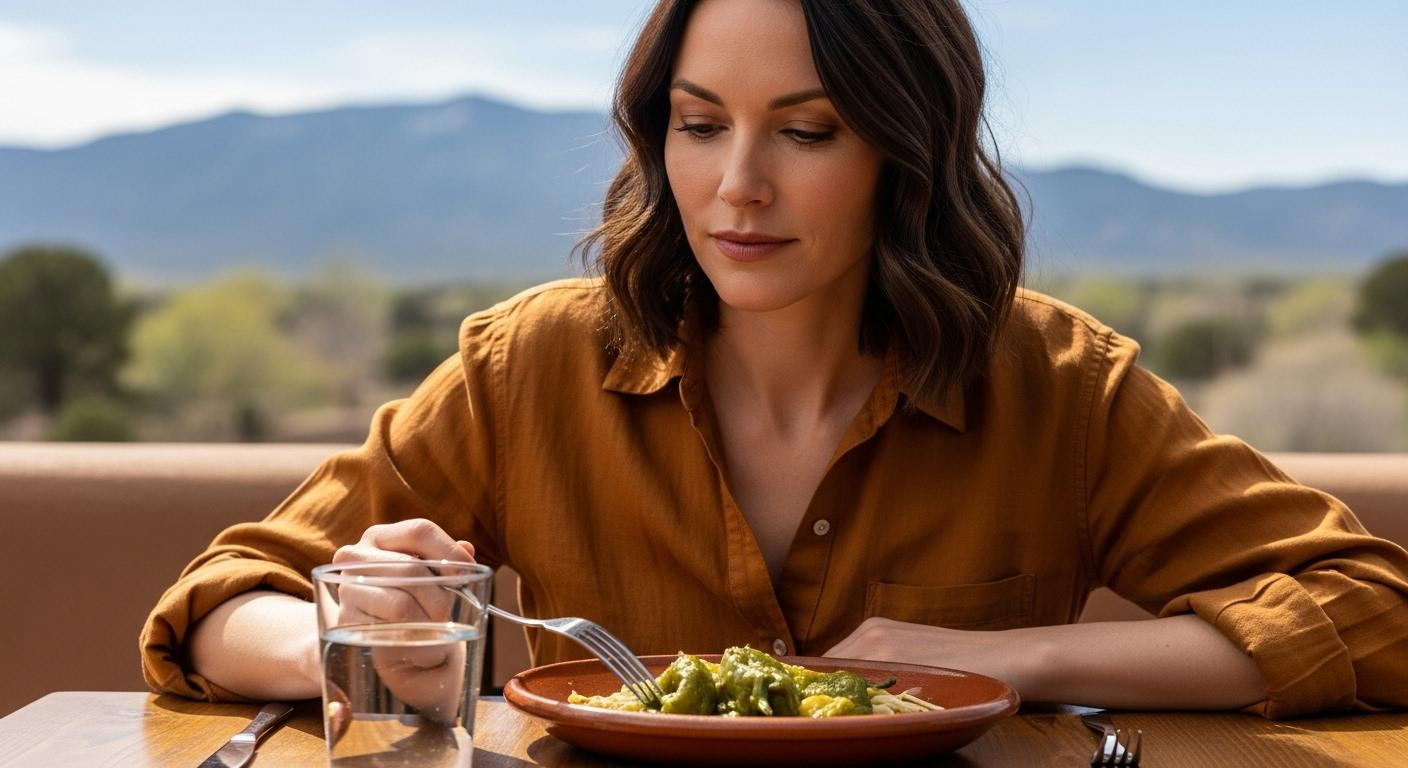Golden light touches adobe walls at 6:47 AM on the Plaza. Steam rises from coffee while a gallery owner unlocks doors her family has opened since 1952. Three days ago, “best city” meant skyline photos and Michelin stars.
Now, standing where 415 years of cultural protection has created something most of America has lost, the truth crystallizes. Time moves differently here. Art lives rather than performs. Food connects rather than impresses.
Santa Fe doesn’t just preserve history. It transforms how you see what American culture could be.
When light becomes architecture
The immediate sensory shift hits at 7,199 feet: crystalline air, earth tones mandated by building codes since 1957. Piñon smoke scent drifts from chimneys. The Sangre de Cristo Mountains frame everything in dramatic relief.
Your first walk through the Plaza reveals truth. This isn’t a tourist space but a living room where locals gather daily. Native American vendors spread jewelry on blankets under the Palace of the Governors portal.
Mission bells mark time in centuries, not minutes. Adobe corners catch golden hour light, vigas cast geometric shadows, chile ristras punctuate doorways like prayer flags.
Three blocks in, realization dawns: this isn’t preserved history. It’s continuous living culture that protects architectural identity through daily use rather than museum display.
The art that chooses you
What makes Santa Fe’s creative ecosystem different from other art towns? Scale and authenticity converge in unprecedented ways.
Canyon Road’s gallery ritual
Here, browsing becomes encountering. Over 250 galleries pack the walkable downtown, with Canyon Road containing “the most art studios per block than anywhere else in the world.” Artists work in back studios, pieces evolve over return visits, conversations replace sales pitches.
The Georgia O’Keeffe Museum houses 1,000+ works revealing why she declared Santa Fe her spiritual home. The light, the bones, the space. Friday evening gallery walks flow with wine where locals outnumber tourists 3-to-1.
Native American arts that predate tourism
The Palace of the Governors portal (America’s oldest public building, 1610) operates under strict authenticity rules. Pueblo artists sell family traditions spanning generations, techniques unchanged for centuries.
Santa Fe Indian Market draws 100,000 visitors each August but operates year-round through local relationships. The difference between craft and commodity becomes crystal clear when you witness living traditions.
The chile that defines community
Food here functions as cultural anchor, not trend. Travel + Leisure readers “raved about the inventive New Mexican cuisine” that earned Santa Fe its 88.8 score in 2025’s World’s Best Awards.
Red or green: the state question
Chile culture runs ritualistic deep. Autumn roasting fills neighborhoods with smoke, family recipes guard secrets fiercely, Christmas (“both”) offers spiritual compromise. Farm-to-table existed here before becoming marketing.
The Santa Fe School of Cooking teaches traditions, not techniques. Blue corn pancakes, posole, biscochitos carry centuries of adaptation: Native, Spanish, Mexican, Anglo layers in every bite.
Meals that last three hours
Restaurant culture builds around conversation, not turnover. Terra at Four Seasons overlooks Jemez Mountains, Dolina Café provides neighborhood intimacy, Ozu proves Japanese-New Mexican fusion works.
The transformative realization hits over your second hour at dinner: slow food enables slow time enables slow living. Counter-cultural in 2025 America, but authentically local here.
The silence that teaches
November’s empty trails (Aspen Vista, Cross of the Martyrs sunrise) offer high desert stillness. The paradox: a UNESCO Creative City maintains profound quiet.
What changes in three days transforms relationships with phones, comfort with silence, acceptance of not-knowing. Locals’ secret: they stay because Santa Fe makes hurry feel violent.
Departure contrast hits hard. Airport chaos, highway speed, city noise reveal what you’ve internalized. Not nostalgia but integration. The question forms: what if I lived like this?
Near stress-reducing trails, transformation accelerates through altitude and solitude.
Your questions about Santa Fe: the best U.S. city of 2025 answered
Is Santa Fe worth the travel cost and altitude adjustment?
ABQ flights run $150-$400 depending on origin, with a scenic 1-hour drive to Santa Fe. Altitude adjustment requires drinking water and moving slowly Day 1. Fall (September-October) offers 45-75°F perfection with fewer crowds than summer’s Indian Market peak. Accommodation: $80-$800+ nightly, sweet spot $150-$250 for authentic casitas. Budget $12-$70 per meal. Three days minimum for transformative experience versus checklist tourism.
What makes Santa Fe’s art scene actually different?
Scale matters: 100+ Canyon Road galleries, Georgia O’Keeffe Museum, plus daily Native American portal market. Critical difference: artists live, work, and show here rather than visiting colonies. Everything stays walkable, conversations happen directly with creators, return visits build relationships. UNESCO designation recognizes living tradition, not frozen heritage.
How does Santa Fe compare to Sedona or Taos?
Santa Fe offers deeper cultural infrastructure (museums, Native history, culinary sophistication) than Taos’s bohemian intimacy, less New Age commodification than Sedona’s vortex tourism, more walkable than both. Sedona equals nature spirituality, Taos equals art colony remoteness. Santa Fe equals living multicultural city at human scale. Choose based on priority: transformation versus escape versus creative solitude.
The last evening, adobe walls glow amber in light that painters chase. Locals pass with quiet nods, unhurried. Three days ago, “best city” was abstract. Now it’s visceral: the weight of a handmade bowl, the taste of green chile, the gift of walking slowly.
